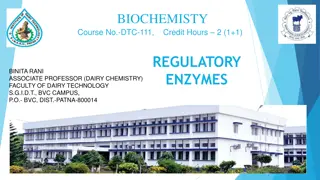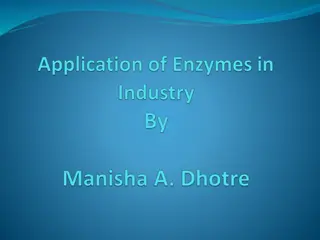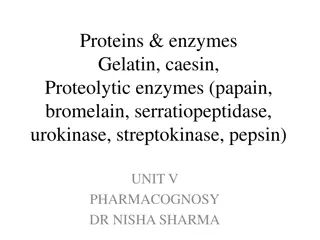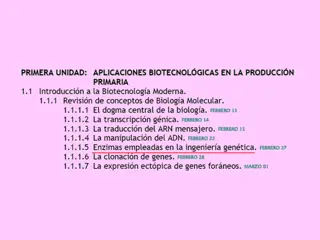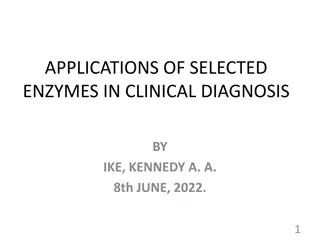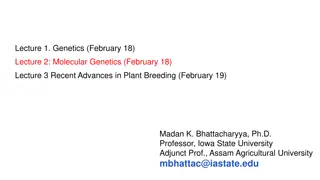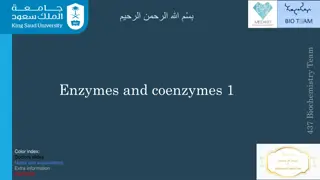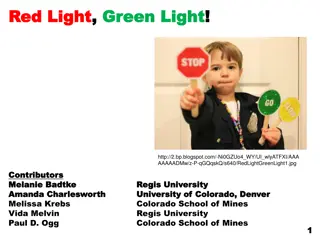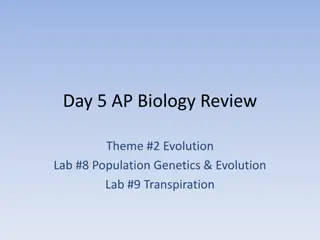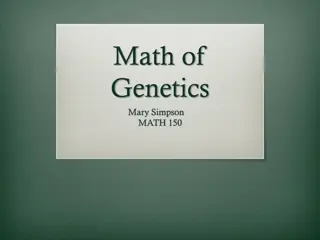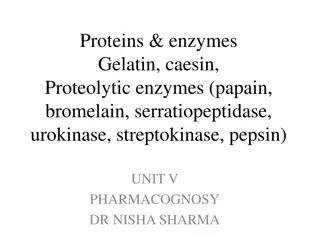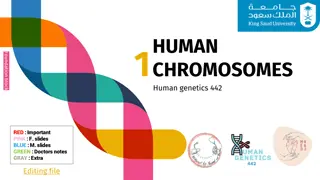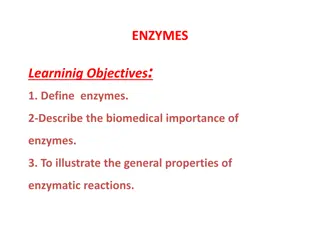Biology Review: Genetics, Enzymes, and Cell Division
Explore key concepts in AP Biology, including genetic continuity and change, enzyme catalysis, mitosis, and meiosis. Understand the mechanisms of genetic variability and cell division processes. Dive into enzyme-substrate interactions and the differences between mitosis and meiosis.
Download Presentation

Please find below an Image/Link to download the presentation.
The content on the website is provided AS IS for your information and personal use only. It may not be sold, licensed, or shared on other websites without obtaining consent from the author. Download presentation by click this link. If you encounter any issues during the download, it is possible that the publisher has removed the file from their server.
E N D
Presentation Transcript
Day 2 of AP Review AP Biology Vocabulary Mania Get a flash card and quiz at least three people then have a seat to start your quick write.
Quick write Continuity and Change All species tend to maintain themselves from generation to generation using the same genetic code. However, there are genetic mechanisms that lead to change over time, or evolution. Example: Mitosis consistently replicates cells in an organism; meiosis (and hence sexual reproduction) results in genetic variability. Comment (discuss) on either of the first two examples or come up with one or two more examples of continuity & change and discuss how they relate to continuity & change.
Review lab #2 Enzyme Catalysis What was the enzyme? What was the substrate? What was the product in the reaction? How could you prove that the gas emitted was O2? If you were to draw a graph, what would be the independent variable and the dependent variable? How would you title it? What was the best temperature? Why? What was the best enzyme & substrate concentration? Why?
Review Lab #3 Compare & Contrast Mitosis & Meiosis Mitosis Formation of new cells genetically identical to parent cell New somatic cells for growth and repair Formation of adult from zygote Asexual reproduction in unicellular organisms Regeneration Meiosis Reduction of chromosome number Formation of gametes in animals Formation of spores in plants
Mitosis Prophase duplicated homologous chromosomes do not pair to form tetrads, & crossing over between homologous chromosomes does not occur Metaphase individual chromosomes align independently of one another at the metaphase plate. Anaphase Sister chromatids of each duplicated chromosomes stay together and homologous pairs of chromosomes separate. Homologous chromatids are separted during the meiotic division.
Meiosis Prophase I duplicated homologous chromosome pair to form tetrads, and crossing over does occur between homologous chromosomes. Metaphase I tetrads align at the metaphase plate. Anaphase I sister chromatids of each duplicated chromosome stay together and homologous pair of chromosomes separate. Homologous chromatids are separated during the second meiotic division.
Comparing Mitosis & meiosis Mitosis Meiosis Chromosome Number of Parents 2N 2N Number of DNA Replications 1 1 Number of Divisions 1 2 Number of Daughter Cells Produced 2 4 Chromosome Number of Daughter Cells 2N N Purpose/ Function Growth, Repair, Replace Formation of gametes and spores
Fetal Pig Dissection Continuity & change Both the Fetal Pig and humans have DNA, but DNA is coded differently to produce different proteins.
Good Review Study Questions The continuity of life is based on heritable information in the form of DNA. In a short essay (100 150 ) words, explain how the process of mitosis faithfully parcels out exact copies of this heritable information in the production of genetically identical daughter cells.
The continuity of life is based on heritable information in the form f DNA. In a short essay (100 150 words), explain how chromosomes behavior during sexual reproduction in animals ensures perpetuation of parental traits in offspring and , at the same time, genentic variation among offspring.
Cell Cycle Check points exist at G1, G2 & M. A checkpoint is a control point where the signals for stop and go ahead regulate the cycle. These signals report whether important cellular processes have occurred by that point in the cycle. G0phase is the non-dividing state where the cell exits the cell cycle Cells in the body that are in G0phase are the nerve cells and muscle cells that never divide.


